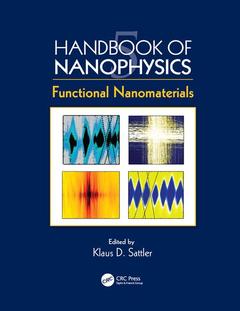Handbook of Nanophysics Functional Nanomaterials Handbook of Nanophysics Series
Coordonnateur : Sattler Klaus D.

Handbook of Nanophysics: Functional Nanomaterials illustrates the importance of tailoring nanomaterials to achieve desired functions in applications. Each peer-reviewed chapter contains a broad-based introduction and enhances understanding of the state-of-the-art scientific content through fundamental equations and illustrations, some in color.
This volume covers various composites, including carbon nanotube/polymer composites, printable metal nanoparticle inks, polymer?clay nanocomposites, biofunctionalized titanium dioxide-based nanocomposites, nanocolorants, ferroic nanocomposites, and smart composite systems. It also describes nanoporous materials, a giant nanomembrane, graphitic foams, arrayed nanoporous silicon pillars, nanoporous anodic oxides, metal oxide nanohole arrays, carbon clathrates, self-assembled monolayers, epitaxial graphene, and graphene nanoribbons, nanostructures, quantum dots, and cones. After focusing on the methods of nanoindentation and self-patterning, the book discusses nanosensors, nano-oscillators, and hydrogen storage.
Nanophysics brings together multiple disciplines to determine the structural, electronic, optical, and thermal behavior of nanomaterials; electrical and thermal conductivity; the forces between nanoscale objects; and the transition between classical and quantum behavior. Facilitating communication across many disciplines, this landmark publication encourages scientists with disparate interests to collaborate on interdisciplinary projects and incorporate the theory and methodology of other areas into their work.
Nanocomposites. Nanoporous and Nanocage Materials. Nanolayers. Indentation and Patterning. Nanosensors. Nano-Oscillators. Hydrogen Storage. Index.
Klaus D. Sattler is a professor of physics at the University of Hawaii-Manoa in Honolulu. A pioneer in nanophysics, Dr. Sattler built the first atomic cluster source in 1980, which became a cornerstone for nanoscience and nanotechnology. In 1994, his research group at the University of Hawaii produced the first carbon nanocones. His current research focuses on novel nanomaterials, tunneling spectroscopy of quantum dots, and solar photocatalysis with nanoparticles for the purification of water. Dr. Sattler has been a recipient of the Walter Schottky Prize from the German Physical Society
Date de parution : 08-2017
21x28 cm
Date de parution : 09-2010
21.9x27.6 cm
Thèmes de Handbook of Nanophysics :
Mots-clés :
Metal Assisted Chemical Etching; FE SEM Photograph; Nanoporous and Nanocage Materials; Graphene Quantum Dots; Indentation and Patterning; Nanohole Arrays; Nano-Oscillators; QDIP; Hydrogen Storage; SEM; Nanocomposites; STM; Graphene Nanoribbons; QDs; Binding Energies; Dirac Point; Transition Metal; H2 Molecule; Graphene Sheet; CNTs; Self-Assembled Monolayers; Graphene Nanostructures; Epitaxial Graphene; Polymer Clay Nanocomposites; Nanomechanical Resonators; Nanoporous Materials; Nanoporous Carbon; Anodic Alumina; Zigzag Nanoribbons



